The Performance of Multiple Model-Simulated Soil Moisture Datasets Relative to ECV Satellite Data in China
Abstract
:1. Introduction
2. Study Area and Data
2.1. ECV Dataset
2.2. CMIP5 Soil Moisture
2.3. ISIMIP Soil Moisture
2.4. GLDAS Soil Moisture
2.5. Reanalysis Soil Moisture
2.6. Precipitation and Vegetation Datasets
3. Methods
3.1. Data Inspection
3.2. Data Preprocessing
3.3. Statistical Metrics
4. Results
4.1. Comparison of Spatial Patterns of Annual Mean Soil Moisture
4.2. Comparison of Soil Moisture Time Series in the Datasets
4.3. Comparison of Long-Term Seasonal Trends of the Soil Moisture Datasets
5. Conclusions
6. Discussion
Supplementary Materials
Author Contributions
Funding
Acknowledgments
Conflicts of Interest
References
- Srinivasan, G.; Robock, A.; Entin, J.K.; Luo, L.; Vinnikov, K.Y.; Viterbo, P. Soil moisture simulations in revised amip models. J. Geophys. Res. Atmos. 2000, 105, 26635–26644. [Google Scholar] [CrossRef]
- Koster, R.D.; Yamada, T. Regions of strong coupling between soil moisture and precipitation. Science 2004, 305, 1138–1140. [Google Scholar] [CrossRef] [PubMed]
- Fischer, E.M.; Seneviratne, S.I.; Vidale, P.L.; Lüthi, D.; Schär, C. Soil moisture atmosphere interactions during the 2003 european summer heat wave. J. Clim. 2007, 20, 5081. [Google Scholar] [CrossRef]
- Jung, M.; Reichstein, M.; Ciais, P.; Seneviratne, S.I.; Sheffield, J.; Goulden, M.L.; et al. Recent decline in the global land evapotranspiration trend due to limited moisture supply. Nature 2010, 467, 951–954. [Google Scholar] [CrossRef] [PubMed] [Green Version]
- Amani, M.; Salehi, B.; Mahdavi, S.; Masjedi, A.; Dehnavi, S. Temperature-Vegetation-soil Moisture Dryness Index (TVMDI). Remote Sens. Environ. 2017, 197, 1–14. [Google Scholar] [CrossRef]
- Seneviratne, S.I.; Corti, T.; Davin, E.L.; Hirschi, M.; Jaeger, E.B.; Lehner, I.; Bonan, G.; Cescatti, A.; Chen, J.; de Jeu, R.; et al. Investigating soil moisture–climate interactions in a changing climate: A review. Earth-Sci. Rev. 2010, 99, 125–161. [Google Scholar] [CrossRef]
- Li, H.; Shen, W.; Zou, C.; Jiang, J.; Fu, L.; She, G. Spatio-temporal variability of soil moisture and its effect on vegetation in a desertified aeolian riparian ecotone on the tibetan plateau, China. J. Hydrol. 2013, 479, 215–225. [Google Scholar] [CrossRef]
- Bi, H.; Ma, J.; Zheng, W.; Zeng, J. Comparison of soil moisture in GLDAS model simulations and in situ observations over the Tibetan Plateau. J. Geophys. Res. Atmos. 2016, 121, 2658–2678. [Google Scholar] [CrossRef]
- Albergel, C.; de Rosnay, P.; Gruhier, C.; Muñoz-Sabater, J.; Hasenauer, S.; Isaksen, L.; Kerr, Y.; Wagner, W. Evaluation of remotely sensed and modelled soil moisture products using global ground-based in situ observations. Remote Sens. Environ. 2012, 118, 215–226. [Google Scholar] [CrossRef]
- Yang, K. A multi-scale soil moisture and freeze-thaw monitoring network on the tibetan plateau and its applications. Bull. Am. Meteorol. Soc. 2013, 94, 1907–1916. [Google Scholar] [CrossRef]
- Gao, Z.; Chae, N.; Kim, J.; Hong, J.; Choi, T.; Lee, H. Modeling of surface energy partitioning, surface temperature, and soil wetness in the tibetan prairie using the simple biosphere model 2 (sib2). J. Geophys. Res. Atmos. 2004, 109, 439–447. [Google Scholar] [CrossRef]
- Yang, Z.; Hua, O.; Zhang, X.; Xu, X.; Zhou, C.; Yang, W. Spatial variability of soil moisture at typical alpine meadow and steppe sites in the qinghai-tibetan plateau permafrost region. Environ. Earth Sci. 2011, 63, 477–488. [Google Scholar] [CrossRef]
- Zhang, X.F.; Zhao, L.; Xu, S.J.; Liu, Y.Z.; Liu, H.Y.; Cheng, G.D. The influence of soil moisture on bacterial and fungal communities in beilu river (tibetan plateau) permafrost soils with different vegetation types. J. Appl. Microbiol. 2012, 114, 1054–1065. [Google Scholar] [CrossRef] [PubMed]
- Taylor, C.M.; de Jeu, R.A.; Guichard, F.; Harris, P.P.; Dorigo, W.A. Afternoon rain more likely over drier soils. Nature 2012, 489, 423. [Google Scholar] [CrossRef] [PubMed] [Green Version]
- Cheng, S.; Huang, J.; Li, F.; Lin, L. Uncertainties of soil moisture in historical simulations and future projections. J. Geophys. Res. Atmos. 2017, 122, 2239–2253. [Google Scholar] [CrossRef]
- Ruosteenoja, K.; Markkanen, T.; Venäläinen, A.; Räisänen, P.; Peltola, H. Seasonal soil moisture and drought occurrence in europe in cmip5 projections for the 21st century. Clim. Dyn. 2017, 50, 1–16. [Google Scholar] [CrossRef]
- Zhao, L.; Yang, K.; Qin, J.; Chen, Y.; Tang, W.; Montzka, C.; Wu, H.; Lin, C.; Han, M.; Vereecken, H. Spatiotemporal analysis of soil moisture observations within a tibetan mesoscale area and its implication to regional soil moisture measurements. J. Hydrol. 2013, 482, 92–104. [Google Scholar] [CrossRef]
- Cheng, S.; Guan, X.; Huang, J.; Ji, F.; Guo, R. Long-term trend and variability of soil moisture over East Asia. J. Geophys. Res. Atmos. 2015, 120, 8658–8670. [Google Scholar] [CrossRef]
- Ochsner, T.E.; Cosh, M.H.; Cuenca, R.H.; Dorigo, W.A.; Draper, C.S.; Hagimoto, Y.; Kerr, Y.H.; Njoku, E.G.; Smali, E.E.; Zreda, M. State of the art in large-scale soil moisture monitoring. Soil Sci. Soc. Am. J. 2013, 77, 1888–1919. [Google Scholar] [CrossRef] [Green Version]
- Brocca, L.; Hasenauer, S.; Lacava, T.; Melone, F.; Moramarco, T.; Wagner, W.; Dorigo, W.; Matgen, P.; Martínez-Fernándeze, J.; Llorensf, P.; et al. Soil moisture estimation through ASCAT and AMSR-E sensors: An intercomparison and validation study across Erope. Remote Sens. Environ. 2011, 115, 3390–3408. [Google Scholar] [CrossRef]
- Koike, T.; Nakamura, Y.; Kaihotsu, I.; Davaa, G.; Matsuura, N.; Tamagawa, K.; Fujii, H. Development of an advanced microwave scanning radiometer (AMSR-E) algorithm for soil moisture and vegetation water content. Doboku Gakkai Ronbunshuu B 2004, 48, 217–222. [Google Scholar] [CrossRef]
- Kerr, Y.H.; Waldteufel, P.; Wigneron, J.P.; Delwart, S.; Cabot, F.O.; Boutin, J.; Escorihuela, M.-J.; Font, J.; Reul, N.; Gruhier, C.; et al. The SMOS mission: New tool for monitoring key elements of the global water cycle. Proc. IEEE. 2010, 98, 666–687. [Google Scholar] [CrossRef] [Green Version]
- Kerr, Y.H.; Waldteufel, P.; Richaume, P.; Wigneron, J.P.; Ferrazzoli, P.; Mahmoodi, A.; Bitar, A.A.; Cabot, F.; Gruhier, C.; Jugleat, S.E.; et al. The smos soil moisture retrieval algorithm. IEEE Trans. Geosci. Remote 2012, 50, 1384–1403. [Google Scholar] [CrossRef]
- Njoku, E.G.; Chan, S.K. Vegetation and surface roughness effects on AMSR-E land observations. Remote Sens. Environ. 2006, 100, 190–199. [Google Scholar] [CrossRef]
- Naeimi, V.; Scipal, K.; Bartalis, Z.; Hasenauer, S.; Wagner, W. An improved soil moisture retrieval algorithm for ers and metop scatterometer observations. IEEE Trans. Geosci. Remote 2009, 47, 1999–2013. [Google Scholar] [CrossRef]
- Entekhabi, D.; Njoku, E.G.; Neill, P.E.; Kellogg, K.H.; Crow, W.T.; Edelstein, W.N.; Entin, J.K.; Goodman, S.D.; Jackson, T.J.; Johnson, J.; et al. The soil moisture active passive (SMAP) mission. Proc. IEEE 2010, 98, 704–716. [Google Scholar] [CrossRef]
- Owe, M.; Jeu, R.D.; Holmes, T. Multisensor historical climatology of satellite-derived global land surface moisture. J. Geophys. Res.-Earth Surf. 2008, 113, 1–17. [Google Scholar] [CrossRef]
- Dorigo, W.; Jeu, R.D.; Chung, D.; Parinussa, R.; Liu, Y.; Wagner, W.; Fernández-Prieto, D. Evaluating global trends (1988–2010) in harmonized multi-satellite surface soil moisture. Geophys. Res. Lett. 2012, 39, 18405. [Google Scholar] [CrossRef]
- Parinussa, R.; Meesters, A.G.C.A.; Liu, Y.Y.; Dorigo, W.; Wagner, W.; De Jeu, R.A.M. An analytical solution to estimate the error structure of a global soil moisture dataset. IEEE Geosci. Remote Sens. Lett. 2011, 8, 779–783. [Google Scholar] [CrossRef]
- Chen, X.; Su, Y.; Liao, J.; Shang, J.; Dong, T.; Wang, C.; Liu, W.; Zhou, G.; Liu, L. Detecting significant decreasing trends of land surface soil moisture in eastern China during the past three decades (1979–2010). J. Geophys. Res. Atmos. 2016, 121, 5177–5192. [Google Scholar] [CrossRef]
- Dorigo, W.A.; Gruber, A.; Jeu, R.A.M.D.; Wagner, W.; Stacke, T.; Loew, A.; Albergel, C.; Brocca, L.; Chung, D.; Parinussa, R.M.; et al. Evaluation of the ESA CCI soil moisture product using ground-based observations. Remote Sens. Environ. 2015, 162, 380–395. [Google Scholar] [CrossRef]
- Feng, H. Individual contributions of climate and vegetation change to soil moisture trends across multiple spatial scales. Sci. Rep. 2016, 6, 32728. [Google Scholar] [CrossRef] [PubMed]
- Liu, Y.Y.; Parinussa, R.M.; Dorigo, W.A.; De Jeu, R.A.M.; Wagner, W.; van Dijk, A.I.J.M.; McCabe, M.F.; Evans, J.P. Developing an improved soil moisture dataset by blending passive and active microwave satellite-based retrievals. Hydrol. Earth Syst. Sci. 2011, 15, 425–436. [Google Scholar] [CrossRef] [Green Version]
- Liu, Y.Y.; Dorigo, W.A.; Parinussa, R.M.; De Jeu, R.A.M.; Wagner, W.; McCabe, M.F.; Evans, J.P.; van Dijk, A.I.J.M. Trend-preserving blending of passive and active microwave soil moisture retrievals. Remote Sens. Environ. 2012, 123, 280–297. [Google Scholar] [CrossRef]
- Zeng, J.; Li, Z.; Chen, Q.; Bi, H.; Qiu, J.; Zou, P. Evaluation of remotely sensed and reanalysis soil moisture products over the tibetan plateau using in-situ observations. Remote Sens. Environ. 2015, 163, 91–110. [Google Scholar] [CrossRef]
- Nicolai-Shaw, N.; Hirschi, M.; Mittelbach, H.; Seneviratne, S.I. Spatial representativeness of soil moisture using in situ, remote sensing, and land reanalysis data. J. Geophys. Res. Atmos. 2015, 120, 9955–9964. [Google Scholar] [CrossRef] [Green Version]
- An, R.; Zhang, L.; Wang, Z.; Quaye-Ballard, J.A.; You, J.; Shen, X.; Gao, W.; Huang, L.; Zhao, Y.; Ke, Z. Validation of the esa cci soil moisture product in China. Int. J. Appl. Earth Obs. Geoinf. 2016, 48, 28–36. [Google Scholar] [CrossRef]
- Jing, W.; Song, J.; Zhao, X. A comparison of ecv and smos soil moisture products based on oznet monitoring network. Remote Sens. 2018, 10, 703. [Google Scholar] [CrossRef]
- Yuan, S.; Quiring, S.M. Evaluation of soil moisture in CMIP5 simulations over the contiguous United States using in situ and satellite observations. Hydrol. Earth Syst. Sci. 2017, 21, 2203–2218. [Google Scholar] [CrossRef] [Green Version]
- Loew, A.; Stacke, T.; Dorigo, W.; de Jeu, R.; Hagemann, S. Potential and limitations of multidecadal satellite soil moisture observations for selected climate model evaluation studies. Hydrol. Earth Syst. Sci. 2013, 17, 3523–3542. [Google Scholar] [CrossRef] [Green Version]
- Feng, H.; Zhang, M. Global land moisture trends: Drier in dry and wetter in wet over land. Sci. Rep. 2015, 5. [Google Scholar] [CrossRef] [PubMed]
- Qiu, J.; Gao, Q.; Wang, S.; Su, Z. Comparison of temporal trends from multiple soil moisture data sets and precipitation: The implication of irrigation on regional soil moisture trend. Int. J. Appl. Earth Obs. Geoinf. 2016, 48, 17–27. [Google Scholar] [CrossRef] [Green Version]
- Dorigo, W.; Wagner, W.; Albergel, C.; Albrecht, F.; Balsamo, G.; Brocca, L.; Chung, D.; Ertl, M.; Forkel, M.; Gruber, A.; et al. ESA CCI soil moisture for improved earth system understanding: State-of-the art and future directions. Remote Sens. Environ. 2017, 203, 185–215. [Google Scholar] [CrossRef]
- Szczypta, C.; Calvet, J.C.; Maignan, F.; Dorigo, W.; Baret, F.; Ciais, P. Suitability of modelled and remotely sensed essential climate variables for monitoring Euro-Mediterranean droughts. Geosci. Model Dev. 2014, 7, 931–946. [Google Scholar] [CrossRef] [Green Version]
- Reichle, R.H.; Koster, R.D.; Liu, P.; Mahanama, S.P.P.; Njoku, E.G.; Owe, M. Comparison and assimilation of global soil moisture retrievals from the advanced microwave scanning radiometer for the earth observing system (AMSR-E) and the scanning multichannel microwave radiometer (SMMR). J. Geophys. Res. Atmos. 2007, 112. [Google Scholar] [CrossRef]
- Van, d.V.R.; Salama, M.S.; Pellarin, T.; Ofwono, M.; Ma, Y.; Su, Z. Long term soil moisture mapping over the tibetan plateau using special sensor microwave/imager. Hydrol. Earth Syst. Sci. 2013, 18, 6629–6667. [Google Scholar]
- Zeng, J.; Li, Z.; Chen, Q.; Bi, H. Method for soil moisture and surface temperature estimation in the tibetan plateau using spaceborne radiometer observations. IEEE Geosci. Remote Sens. Lett. 2015, 12, 97–101. [Google Scholar] [CrossRef]
- Rodell, M.; Houser, P.R.; Jambor, U.; Gottschalck, J.; Mitchell, K.; Meng, C.-J.; Arsenault, K.; Cosgrove, B.; Radakovich, J.; Bosilovich, M.; et al. The Global Land Data Assimilation System. Bull. Am. Meteorol. Soc. 2004, 85, 381–394. [Google Scholar] [CrossRef] [Green Version]
- Taylor, K.E.; Stouffer, R.J.; Meehl, G.A. An overview of CMIP5 and the experiment design. Bull. Am. Meteorol. Soc. 2012, 93, 485–498. [Google Scholar] [CrossRef]
- Crow, W.T.; Berg, A.A.; Cosh, M.H.; Loew, A.; Mohanty, B.P.; Panciera, R.; de Rosnay, P.; Ryu, D.; Walker, J.P. Upscaling sparse ground-based soil moisture observations for the validation of coarse-resolution satellite soil moisture products. Rev. Geophys. 2012, 50. [Google Scholar] [CrossRef] [Green Version]
- Su, Z.; Wen, J.; Dente, L.; van der Velde, R.; Wang, L.; Ma, Y.; Yang, K.; Hu, Z. The tibetan plateau observatory of plateau scale soil moisture and soil temperature (Tibet-Obs) for quantifying uncertainties in coarse resolution satellite and model products. Hydrol. Earth Syst. Sci. 2011, 15, 2303–2316. [Google Scholar] [CrossRef]
- Sillmann, J.; Kharin, V.V.; Zhang, X.; Zwiers, F.W.; Bronaugh, D. Climate extremes indices in the cmip5 multimodel ensemble: Part 1. Model evaluation in the present climate. J. Geophys. Res. Atmos. 2013, 118, 1716–1733. [Google Scholar] [CrossRef]
- Sillmann, J.; Kharin, V.V.; Zwiers, F.W.; Zhang, X.; Bronaugh, D. Climate extremes indices in the CMIP5 multimodel ensemble: Part 2. Future climate projections. J. Geophys. Res. Atmos. 2013, 118, 2473–2493. [Google Scholar] [CrossRef] [Green Version]
- Warszawski, L.; Frieler, K.; Huber, V.; Piontek, F.; Serdeczny, O.; Schewe, J. The inter-sectoral impact model intercomparison project (ISI–MIP): Project framework. Proc. Natl. Acad. Sci. USA 2014, 111, 3228–3232. [Google Scholar] [CrossRef] [PubMed]
- Dee, D.P.; Uppala, S.M.; Simmons, A.J.; Berrisford, P.; Poli, P.; Kobayashi, S.; Andrae, U.; Balmaseda, M.A.; Balsamo, G.; Bauer, P.; et al. The ERA-interim reanalysis: Configuration and performance of the data assimilation system. Q. J. R. Meteorolog. Soc. 2011, 137, 553–597. [Google Scholar] [CrossRef]
- Rienecker, M.M.; Suarez, M.J.; Gelaro, R.; Todling, R.; Bacmeister, J.; Liu, E.; Bosilovich, M.G.; Schubert, S.D.; Takacs, L.; Kim, G.-K.; et al. MERRA: NASA’s modern-era retrospective analysis for research and applications. J. Clim. 2011, 24, 3624–3648. [Google Scholar] [CrossRef]
- Lau, N.-C.; Nath, M.J. Model simulation and projection of European heat waves in present-day and future climates. J. Clim. 2014, 27, 3713–3730. [Google Scholar] [CrossRef]
- Ferguson, C.R.; Wood, E.F. Observed land-atmosphere coupling from satellite remote sensing and reanalysis. J. Hydrometeorol. 2011, 12, 1221–1254. [Google Scholar] [CrossRef]
- Albergel, C.; Dorigo, W.; Balsamo, G.; Muñoz-Sabater, J.; Rosnay, P.D.; Isaksen, L.; Brocca, L.; de Jeu, R.; Wagner, W. Monitoring multi-decadal satellite earth observation of soil moisture products through land surface reanalyses. Remote Sens. Environ. 2013, 138, 77–89. [Google Scholar] [CrossRef]
- Bitar, A.A.; Leroux, D.; Kerr, Y.H.; Merlin, O.; Richaume, P.; Sahoo, A.; Wood, E.F. Evaluation of smos soil moisture products over continental U.S. using the SCAN/SNOTEL network. IEEE Trans. Geosci. Remote 2012, 50, 1572–1586. [Google Scholar] [CrossRef] [Green Version]
- Qin, D.; Tao, S.; Dong, S.; Luo, Y. Climate, Environmental, and Socioeconomic Characteristics of China. In Climate and Environmental Change in China: 1951–2012; Springer: Berlin/Heidelberg, Germany, 2016. [Google Scholar]
- He, Y. China’s geographical regionalization in Chinese secondary school curriculum (1902–2012). J. Geogr. Sci. 2013, 23, 370–383. [Google Scholar] [CrossRef]
- Berg, A.; Lintner, B.R.; Findell, K.; Giannini, A. Uncertain soil moisture feedbacks in model projections of Sahel precipitation. Geophys. Res. Lett. 2017, 44, 6124–6133. [Google Scholar] [CrossRef]
- Tang, Q.; Oki, T.; Kanae, S. A distributed biosphere hydrological model (DBHM) for large river basin. Proc. Hydraul. Eng. 2006, 50, 37–42. [Google Scholar] [CrossRef]
- Tang, Q.; Oki, T.; Kanae, S.; Hu, H. The influence of precipitation variability and partial irrigation within grid cells on a hydrological simulation. J. Hydrometeorol. 2007, 8, 499–512. [Google Scholar] [CrossRef]
- Bierkens, M.F.P.; van Beek, L.P.H. Seasonal predictability of European discharge: NAO and hydrological response time. J. Hydrometeorol. 2009, 10, 953–968. [Google Scholar] [CrossRef]
- Hanasaki, N.; Kanae, S.; Oki, T.; Masuda, K.; Motoya, K.; Shirakawa, N.; Shen, Y.; Tanaka, K. An integrated model for the assessment of global water resources—Part 1: Model description and input meteorological forcing. Hydrol. Earth Syst. Sci. 2008, 12, 1007–1025. [Google Scholar] [CrossRef]
- Hanasaki, N.; Kanae, S.; Oki, T.; Masuda, K.; Motoya, K.; Shirakawa, N.; Shen, Y.; Tanaka, K. An integrated model for the assessment of global water resources—Part 2: Applications and assessments. Hydrol. Earth Syst. Sci. 2008, 12, 1027–1037. [Google Scholar] [CrossRef]
- Pokhrel, Y.; Hanasaki, N.; Koirala, S.; Cho, J.; Yeh, P.J.-F.; Kim, H.; Kanae, S.; Oki, T. Incorporating anthropogenic water regulation modules into a land surface model. J. Hydrometeorol. 2012, 13, 255–269. [Google Scholar] [CrossRef]
- Rui, H.; Beaudoing, H. Readme Document for Global Land Data Assimilation System Version 2 (GLDAS-2) Products. GES DISC (Goddard Space Flight Center): Greenbelt, MD, USA, 2011. [Google Scholar]
- Alergel, C.; Dorigo, W.; Reichle, R.H.; Balsamo, G.; de Rosnay, P.; Munoz-Sabater, J.; Isaksen, L.; de Jeu, R.; Wagner, W. Skill and global trend Analysis of soil moisture from reanalyses and microwave remote sensing. J. Hydrometeorol. 2013, 14, 1259–1277. [Google Scholar] [CrossRef]
- Saha, S.; Moorthi, S.; Pan, H.L.; Wu, X.R.; Wang, J.D.; Nadiga, S.; Tripp, P.; Kistler, R.; Woollen, J.; Behringer, D.; et al. The NCEP climate forecast system reanalysis. Bull. Am. Meteorol. Soc. 2010, 91, 1015–1057. [Google Scholar] [CrossRef]
- Mo, K.C.; Long, L.N.; Xia, Y.; Yang, S.K.; Schemm, J.E.; Michael, E. Drought indices based on the climate forecast system reanalysis and ensemble NLDAS. J. Hydrometeorol. 2011, 12, 181–205. [Google Scholar] [CrossRef]
- Luo, M.; Lau, N.-C. Heat waves in southern China: Synoptic behavior, long-term change, and urbanization effects. J. Clim. 2017, 30, 703–720. [Google Scholar] [CrossRef]
- Chakravorty, A.; Chahar, B.P.; Sharma, O.P.; Dhanya, C.T. A regional scale performance evaluation of SMOS and ESA-CCI soil moisture products over India with simulated soil moisture from MERRA-Land. Remote Sens. Environ. 2016, 186, 514–527. [Google Scholar] [CrossRef]
- Lakshmi, V. The role of satellite remote sensing in the prediction of ungauged basins. Hydrol. Process. 2004, 18, 1029–1034. [Google Scholar] [CrossRef]
- Dorigo, W.A.; Zurita-Milla, R.; Wit, A.J.W.D.; Brazile, J.; Singh, R.; Schaepman, M.E. A review on reflective remote sensing and data assimilation techniques for enhanced agroecosystem modeling. Int. J. Appl. Earth Obs. Geoinform 2007, 9, 165–193. [Google Scholar] [CrossRef]
- Rodríguez-Fernández, N.J.; Mialon, A.; Mermoz, S.; Bouvet, A.; Richaume, P.; Bitar, A.A.; Al-Yaari, A.; Brandt, M.; Kaminski, T.; Toan, T.L.; et al. The high sensitivity of smos l-band vegetation optical depth to biomass. Biogeosci. Discuss. 2018, 1–20. [Google Scholar] [CrossRef]
- Pinzon, J.E.; Tucker, C.J. A non-stationary 1981–2012 AVHRR NDVI3g time series. Remote Sens. 2014, 6, 6929–6960. [Google Scholar] [CrossRef]
- Escorihuela, M.J.; Quintana-Seguí, P. Comparison of remote sensing and simulated soil moisture datasets in Mediterranean landscapes. Remote Sens. Environ. 2016, 180, 99–114. [Google Scholar] [CrossRef]
- Kendall, M.G. Rank Correlation Methods; Griffin: London, UK, 1975. [Google Scholar]
- Mann, H.B. Nonparametric tests against trend. Econometrica 1945, 13, 245–259. [Google Scholar] [CrossRef]
- Wei, S.; Dai, Y.; Liu, B.; Zhu, A.; Duan, Q.; Wu, L.; Ji, D.; Ye, A.; Yuan, H.; Zhang, Q.; et al. A China data set of soil properties for land surface modeling. J. Adv. Model. Earth Syst. 2013, 5, 212–224. [Google Scholar] [Green Version]
- Batjes, N.H. Soil Parameter Estimates for the Soil Types of the World for Use in Global and Regional Modelling (Version 2.1); ISRIC Report: Wageningen, The Netherlands, 2002. [Google Scholar]
- Batjes, N.H. ISRIC-WISE Derived Soil Properties on a 5 by 5 Arc-Minutes Global Grid; ISRIC Report: Wageningen, The Netherlands, 2006. [Google Scholar]
- Xia, Y.; Ek, M.B.; Wu, Y.; Ford, T.; Quiring, S.M. Comparison of NLDAS-2 simulated and nasmd observed daily soil moisture. part II: Impact of soil texture classification and vegetation type mismatches. J. Hydrometeorol. 2014. [Google Scholar] [CrossRef]
- He, L.; Chen, J.M.; Liu, J.; Bélair, S.; Luo, X. Assessment of SMAP soil moisture for global simulation of gross primary production. J. Geogr. Sci. 2017, 122. [Google Scholar] [CrossRef]
- Shi, W.; Tao, F.; Liu, J. Regional temperature change over the Huang-Huai-Hai Plain: The roles of irrigation versus urbanization. Int. J. Climatol. 2014, 34, 1181–1195. [Google Scholar] [CrossRef]
- Wang, Z.; Zhong, R.; Lai, C.; Chen, J. Evaluation of the GPM IMERG satellite-based precipitation products and the hydrological utility. Atmos. Res. 2017, 196, 151–163. [Google Scholar] [CrossRef]
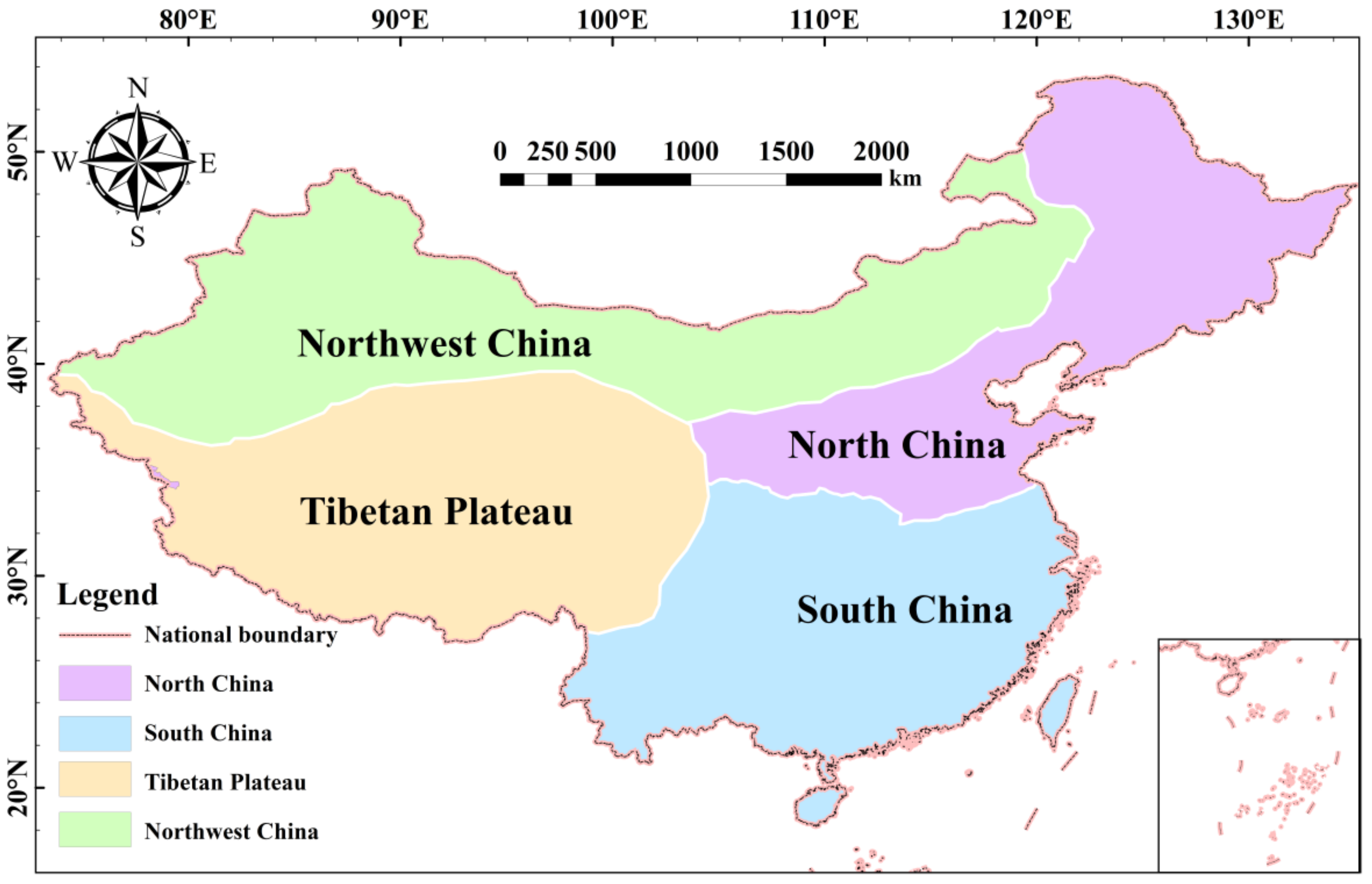


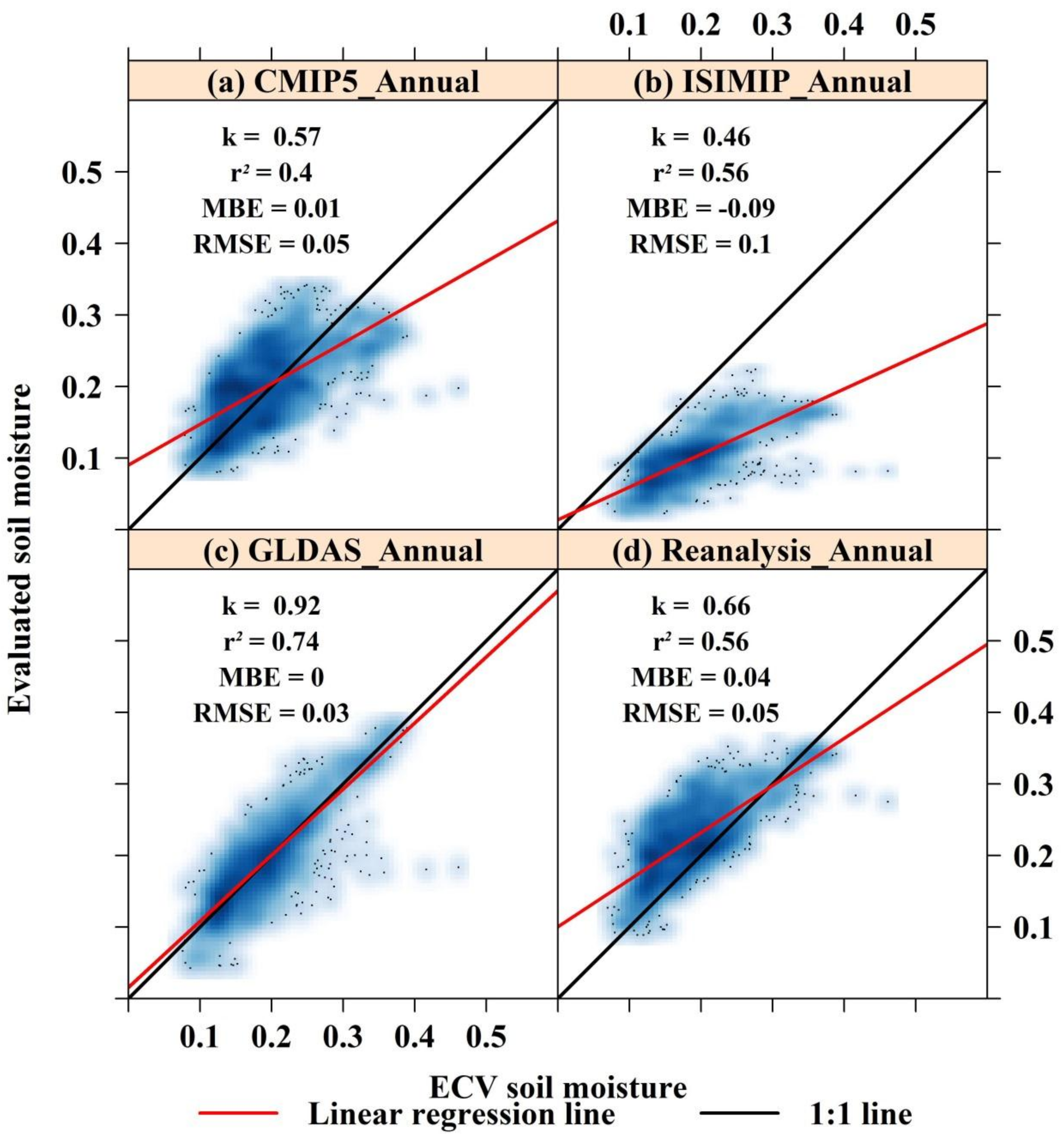
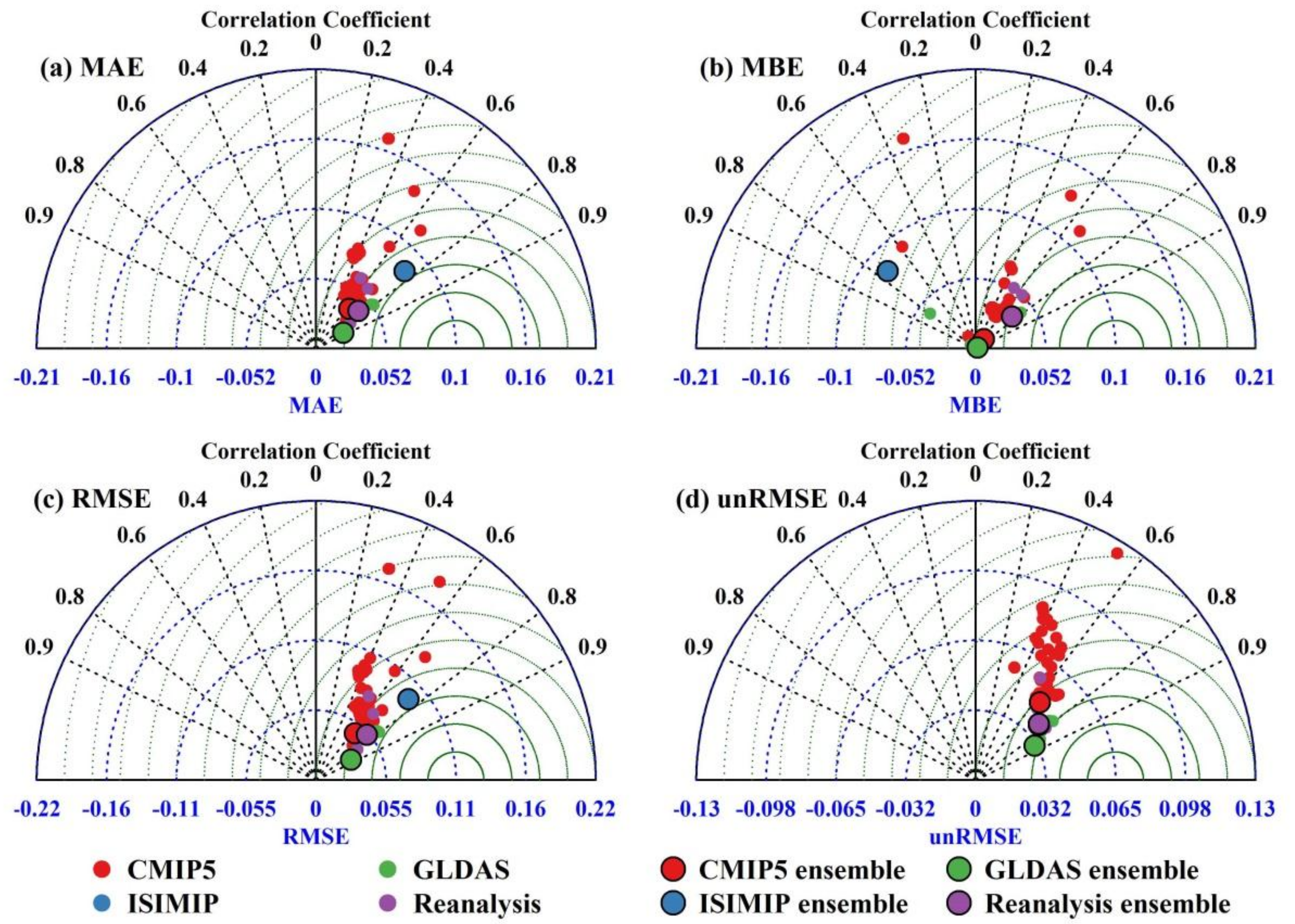


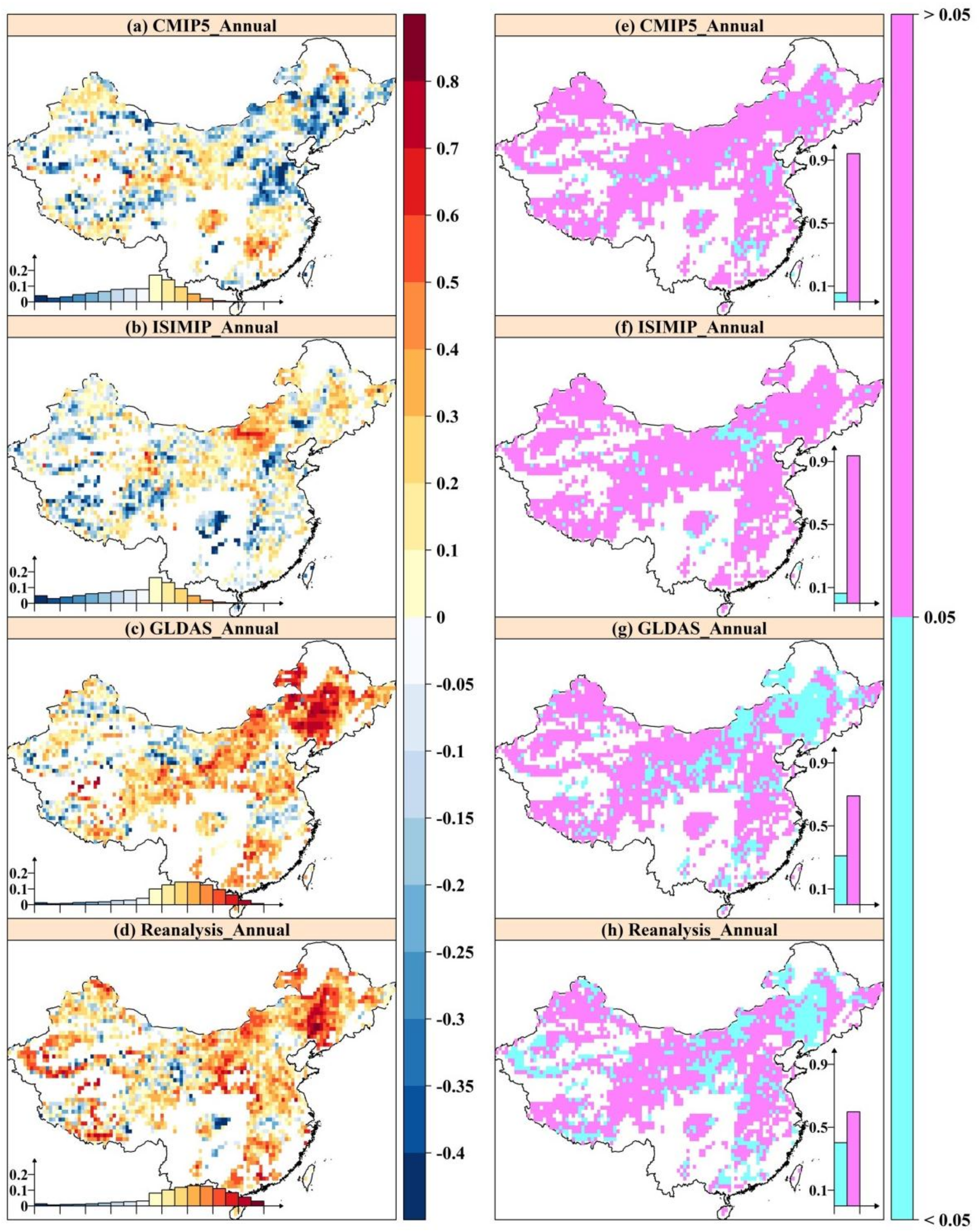

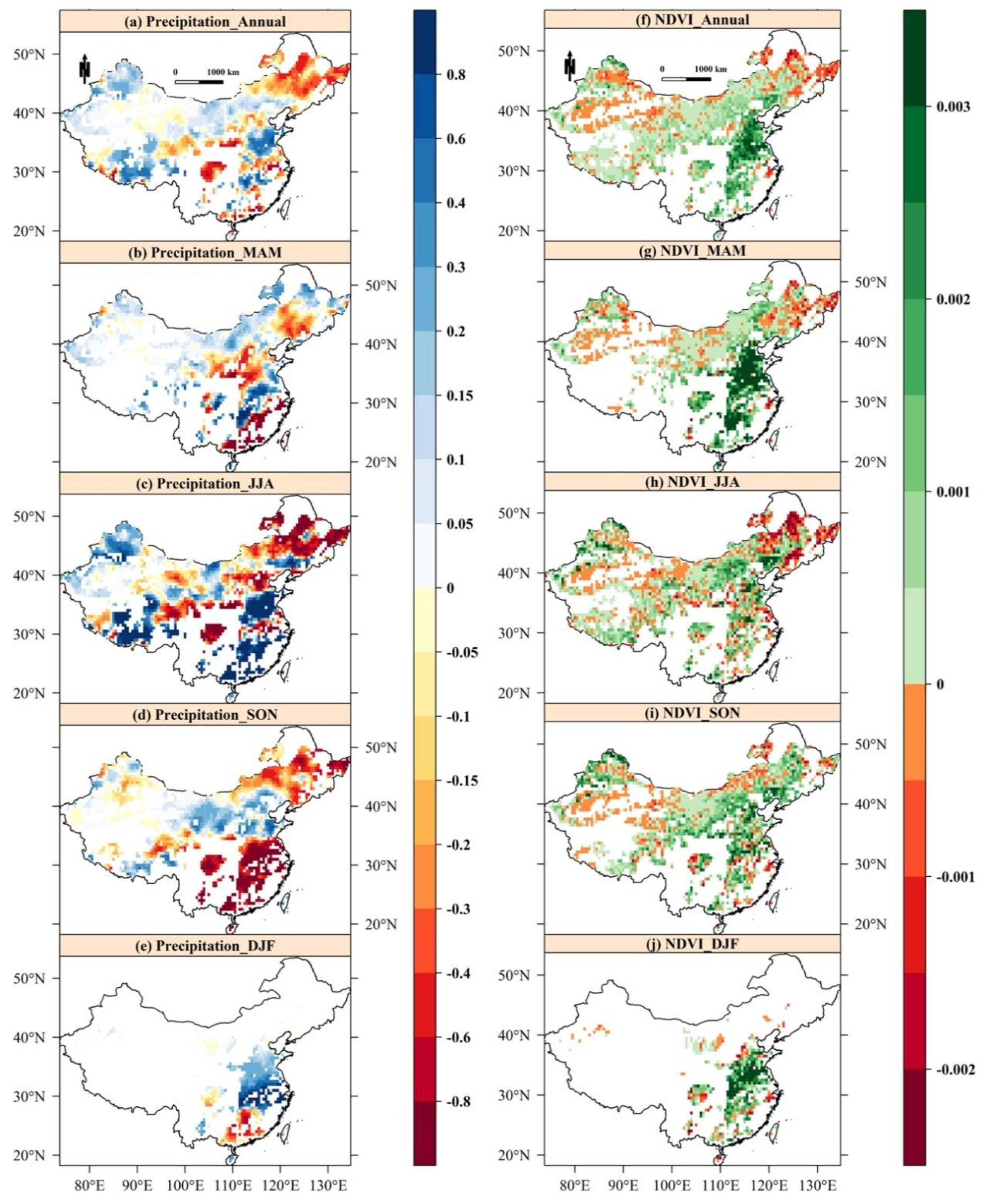

| Datasets (Type) | Full Name | Spatial Resolution | Temporal Resolution | Source |
|---|---|---|---|---|
| ECV (RS observations) | Essential Climate Variable | 0.25° × 0.25° | 1978–2015 | http://www.esa-soilmoisture-cci.org/node. |
| CMIP5 (model simulations) | Coupled Model Intercomparison Project Phase 5 | More detail in Table 1 | https://esgf-node.llnl.gov/search/cmip5/ | |
| ISIMIP (model simulations) | Inter-Sectoral Impact Model Intercomparison Project | 0.5° × 0.5° | 1971–2004/2005 | https://www.isimip.org |
| GLDAS (model simulations) | Global Land Data Assimilation System | 1° × 1° (Version 1) 0.25° × 0.25° (Version 2) | 1979–present 1948–2010 | https://disc.sci.gsfc.nasa.gov/datasets?keywords=GLDAS |
| ERA-Interim (Reanalysis) | European Centre for Medium-Range Weather Forecasts Interim Reanalysis | 0.25° × 0.25° | 1979–present | http://apps.ecmwf.int/datasets/data/interim-full-daily/levtype=sfc/ |
| MERRA (Reanalysis) | Modern-Era Retrospective Analysis for Research and Applications | 1/2° × 2/3° | 1980–present | http://gmao.gsfc.nasa.gov/research/merra/ |
| CSFR (Reanalysis) | Climate Forecast System Reanalysis System | 0.5° × 0.5° | 1979–2010 | http://rda.ucar.edu/pub/cfsr.html |
| Model Datasets | Model Center (or Groups) | Spatial Resolution | Temporal Length |
|---|---|---|---|
| ACCESS1-0 | Commonwealth Scientific and Industrial Research Organization (CSIRO) and Bureau of Meteorology (BOM), Australia | 192 × 145 | 1850–2005 |
| ACCESS1-3 | |||
| BCC-CSM1-1 | Beijing Climate Center, China Meteorological Administration, China | 320 × 160 | 1850–2012 |
| BCC-CSM1-1-m | 128 × 64 | ||
| BNU-ESM | College of Global Change and Earth System Science, Beijing Normal University, China | 128 × 64 | 1850–2005 |
| CanCM4 | Canadian Centre for Climate Modelling and Analysis, Canada | 128 × 64 | 1961–2005 |
| CanESM2 | 1850–2005 | ||
| CCSM4 | National Center for Atmospheric Research, USA | 288 × 192 | 1850–2005 |
| CESM1-BGC | Community Earth System Model Contributors, USA | 288 × 192 | 1850–2005 |
| CESM1-CAM5 | 288 × 192 | ||
| CESM1-FASTCHEM | 288 × 192 | ||
| CESM1-WACCM | 144 × 96 | ||
| CNRM-CM5 | Centre National de Recherches Météorologiques/Centre Européen de Recherche et Formation Avancée en CalculScientifique, France | 256 × 128 | 1850–2005 |
| CNRM-CM5-2 | |||
| CSIRO-MK3-6-0 | Commonwealth Scientific and Industrial Research Organisation in collaboration with the Queensland Climate Change Centre of Excellence, Australia | 192 × 96 | 1850–2005 |
| FGOALS-g2 | LASG(The State Key Laboratory of Numerical Modeling for Atmospheric Sciences and Geophysical Fluid Dynamics), Institute of Atmospheric Physics, Chinese Academy of Sciences; and CESS(The Conference on Earth System Science), Tsinghua University, China | 128 × 60 | 1850–2005 |
| FGOALS-s2 | LASG, Institute of Atmospheric Physics, Chinese Academy of Sciences, China | 128 × 108 | 1850–2005 |
| GFDL-CM3 | Geophysical Fluid Dynamics Laboratory, USA | 144 × 90 | 1860–2005 |
| GFDL-ESM2G | 1861–2005 | ||
| GFDL-ESM2M | 1861–2005 | ||
| GISS-E2-H | NASA(National Aeronautics and Space Administration) Goddard Institute for Space Studies, USA | 144 × 90 | 1850–2005 |
| GISS-E2-H-CC | 1850–2010 | ||
| GISS-E2-R | 1850–2005 | ||
| GISS-E2-R-CC | 1850–2010 | ||
| HadCM3 | Met Office Hadley Centre, UK | 96 × 73 | 1859–2005 |
| inmcm4 | Institute for Numerical Mathematics, Russia | 180 × 120 | 1850–2005 |
| IPSL-CM5A-LR | Institut Pierre-Simon Laplace, France | 96 × 96 | 1850–2005 |
| IPSL-CM5A-MR | 144 × 143 | ||
| IPSL-CM5B-LR | 96 × 96 | ||
| MIROC4h | Atmosphere and Ocean Research Institute (The University of Tokyo), National Institute for Environmental Studies, and Japan Agency for Marine-Earth Science and Technology, Japan | 128 × 64 | 1950–2005 |
| MIROC5 | 1850–2012 | ||
| MIROC-ESM | Japan Agency for Marine-Earth Science and Technology, Atmosphere and Ocean Research Institute (The University of Tokyo), and National Institute for Environmental Studies, Japan | 640 × 320 | 1850–2005 |
| MIROC-ESM-CHEM | 256 × 128 | ||
| MRI-CGCM3 | Meteorological Research Institute, Japan | 320 × 160 | 1850–2005 |
| MRI-ESM1 | |||
| NorESM1-M | Norwegian Climate Centre, Norway | 144 × 96 | 1850–2005 |
| NorESM1-ME |
| Hydrology Models | GCMs | Spatial Resolution | Temporal Length |
|---|---|---|---|
| Hanasaki et al. (2008) model (H08) | GFDL-ESM2M | 0.5° × 0.5° | 1971–2005 |
| IPSL-CM5A-LR | 1971–2005 | ||
| NorESM1-M | 1971–2005 | ||
| PCRaster Global Water Balance (PCR-GLOBWB) | GFDL-ESM2M | 0.5° × 0.5° | 1971–2005 |
| IPSL-CM5A-LR | 1971–2005 | ||
| MIROC-ESM-CHEM | 1971–2005 | ||
| NorESM1-M | 1971–2005 | ||
| Variable Infiltration Capacity (VIC) | GFDL-ESM2M | 0.5° × 0.5° | 1971–2005 |
| IPSL-CM5A-LR | 1971–2005 | ||
| MIROC-ESM-CHEM | 1971–2005 | ||
| NorESM1-M | 1971–2005 | ||
| Water balance model (WBM) | GFDL-ESM2M | 0.5° × 0.5° | 1971–2005 |
| IPSL-CM5A-LR | 1971–2005 | ||
| MIROC-ESM-CHEM | 1971–2005 |
| Datasets | Spatial Resolution | Temporal Resolution | Layers (m) |
|---|---|---|---|
| GLDAS-1 CLM | 1° × 1° | 1979–present | 0–0.018 0.018–0.045 0.045–0.091 |
| GLDAS-1 MOS | 1° × 1° | 1979–present | 0–0.02 |
| GLDAS-1 VIC | 1° × 1° | 1979–present | 0–0.01 |
| GLDAS-1 NOAH | 1° × 1° | 1979–present | 0–0.01 |
| GLDAS-2 NOAH | 0.25° × 0.25° | 1948–2010 | 0–0.1 0.1–0.4 0.4–1 1–2 |
| Statistical Metrics | Full Name | Equations | Descriptions |
|---|---|---|---|
| r | Pearson correlation coefficient | X and Y are equal-length vectors, and N is the number of vector elements. | |
| MAE | Mean absolute error |  | M is the soil moisture value of the dataset, O is the ECV value, and n is the length of the time series. |
| MBE | Mean bias error |  | Same as above |
| RMSE | Root-mean-square error |  | Same as above |
| unRMSE | Unbiased root-mean-square error |  | Refer to RMSE and MBE |
© 2018 by the authors. Licensee MDPI, Basel, Switzerland. This article is an open access article distributed under the terms and conditions of the Creative Commons Attribution (CC BY) license (http://creativecommons.org/licenses/by/4.0/).
Share and Cite
Bai, W.; Gu, X.; Li, S.; Tang, Y.; He, Y.; Gu, X.; Bai, X. The Performance of Multiple Model-Simulated Soil Moisture Datasets Relative to ECV Satellite Data in China. Water 2018, 10, 1384. https://doi.org/10.3390/w10101384
Bai W, Gu X, Li S, Tang Y, He Y, Gu X, Bai X. The Performance of Multiple Model-Simulated Soil Moisture Datasets Relative to ECV Satellite Data in China. Water. 2018; 10(10):1384. https://doi.org/10.3390/w10101384
Chicago/Turabian StyleBai, Wenkui, Xiling Gu, Shenlin Li, Yihan Tang, Yanhu He, Xihui Gu, and Xiaoyan Bai. 2018. "The Performance of Multiple Model-Simulated Soil Moisture Datasets Relative to ECV Satellite Data in China" Water 10, no. 10: 1384. https://doi.org/10.3390/w10101384
APA StyleBai, W., Gu, X., Li, S., Tang, Y., He, Y., Gu, X., & Bai, X. (2018). The Performance of Multiple Model-Simulated Soil Moisture Datasets Relative to ECV Satellite Data in China. Water, 10(10), 1384. https://doi.org/10.3390/w10101384






